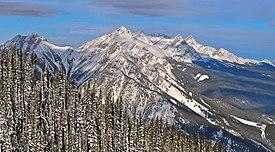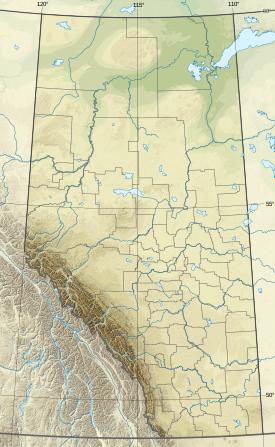| Vermilion Range | |
|---|---|
 | |
| Highest point | |
| Peak | Cascade Mountain |
| Elevation | 2,998 m (9,836 ft) [1] |
| Coordinates | 51°16′05″N 115°34′56″W / 51.26806°N 115.58222°W [2] |
| Dimensions | |
| Area | 142 km2 (55 sq mi) |
| Geography | |
| Country | Canada |
| Province | Alberta |
| Range coordinates | 51°22′N 115°43′W / 51.367°N 115.717°W [3] |
| Parent range | Canadian Rockies |
| Borders on | Sawback Range, Bare Range, Palliser Range and Fairholme Range |
| Topo map | NTS 82O/05 Castle Mountain[3] |
The Vermilion Range is a mountain range of the Canadian Rockies, in Banff National Park, Canada. The range is east of the Sawback Range and west of the Bare and Palliser Ranges.
This range includes the following mountains and peaks:
| Mountain/Peak | metres | feet |
|---|---|---|
| Cascade Mountain | 2,998 | 9,836 |
| Flints Peak | 2,950 | 9,682 |
| Mount Brewster | 2,859 | 9,380 |
| Prow Mountain | 2,858 | 9,377 |
| Mount Norquay | 2,522 | 8,275 |
Geology
The mountains in Banff Park are composed of sedimentary rock laid down during the Precambrian to Jurassic periods.[4] Formed in shallow seas, this sedimentary rock was pushed east and over the top of younger rock during the Laramide orogeny.[5]
Climate
Based on the Köppen climate classification, the range experiences a subarctic climate with cold, snowy winters, and mild summers.[6] Temperatures in winter can drop below −20 °C (−4 °F) with wind chill factors below −30 °C (−22 °F).
References
- ^ "Cascade Mountain". PeakFinder.com. Retrieved 2019-09-17.
- ^ "Cascade Mountain". Geographical Names Data Base. Natural Resources Canada. Retrieved 2019-09-17.
- ^ a b "Vermilion Range". Geographical Names Data Base. Natural Resources Canada. Retrieved 2014-11-09.
- ^ Belyea, Helen R. (1960). The Story of the Mountains in Banff National Park (PDF). parkscanadahistory.com (Report). Ottawa: Geological Survey of Canada. Archived (PDF) from the original on 2015-10-02. Retrieved 2019-09-13.
- ^ Gadd, Ben (2008). "Geology of the Rocky Mountains and Columbias".
- ^ Peel, M. C.; Finlayson, B. L. & McMahon, T. A. (2007). "Updated world map of the Köppen−Geiger climate classification". Hydrol. Earth Syst. Sci. 11: 1633–1644. doi:10.5194/hess-11-1633-2007. ISSN 1027-5606.
